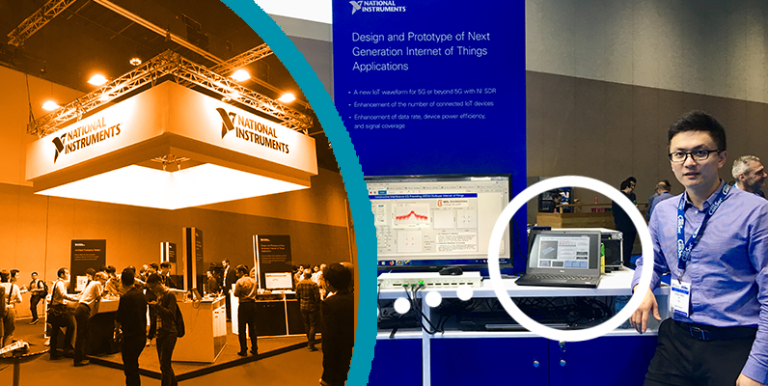ICCS demonstrates wireless connectivity for next generation Internet of Things
19 December 2018
Dr Tongyang Xu, a senior research associate in the Electronic and Electrical Engineering Department, has demonstrated a new method of wireless connectivity to support the next generation of the Internet of Things.

Authors Tongyan Xu, Senior Research Fellow
Robert J. Thompson, Institute manager and Impact Fellow
 IoT | 5G | New radio | SEFDM
IoT | 5G | New radio | SEFDM
Dr Tongyang Xu has presented a prototype method of wireless connectivity developed by members of the Institute of Communications and Connected Systems to support the next generation of the Internet of Things.
The prototype uses technology developed during an EPSRC funded project 'Electronically Steerable Parasitic Array Radiator (ESPAR) transceiver' led by ICCS member Dr Christos Masouros and was presented at the Institute of Electrical and Electronic Engineering's 2018 Global Communications Conference, GLOBECOM, held in Abu Dhabi last week, 9th - 13th December.
The Internet of Things (IoT) has become pervasive within many areas of industry and consumer electronics with the number of applications increasing at an exponential rate and many suggested applications having mission-critical importance.
To address the growing demands of IoT the next generation of this technology deployment must be able to support massive numbers of device connections, increased reliability, enhanced power efficiency, long-range communications and higher rates of data transfer.
The demonstration presented by Dr Xu, a senior research fellow in the Department of Electronic and Electrical Engineering, displayed how a proposed new form of radio-wave, termed 'spectrally efficient frequency division multiplexing (SEFDM)', could address the connectivity demands of future generations of IoT technology.
The new form of radio wave was originally proposed by ICCS director Professor Izzat Darwazeh and has been developed for several use-cases within Institute research projects, including applications for 5G and beyond.
The waveform has multiple benefits which make it suitable for next-generation IoT:
- Extending the number of connected IoT devices without occupying additional resources, e.g. spectrum,
- Increasing the data rate by optimising the waveform rather than adding higher order modulations, this reduces the complexity of the system making it more energy efficient
- Reducing the power demand on the IoT device while increasing signal coverage by intelligently varying the radio frequency through a technique known as waveform scheduling.
In addition, the demonstration also employed state-of-the-art methods to enable multiple signals to travel constructively through the air by analysing their variations with time and making sure they are transmitted at optimum time windows. This method, known as a constructive interference precoding strategy, has potential use in applications for communication technology beyond 5G.
The demonstration was received well by those attending the GLOBECOM conference at which thousands of participants from academia and industry attended to present state-of-the-art research and share new ideas.
National Instruments, a producer of automated test and measurement systems is a long-term collaborator with UCL and invited the ICCS team to present the demonstration at GLOBECOM. The company which produces test and measurement systems have worked with ICCS on two recent EPSRC funded projects, and their software defined radio platform was used in the production of this next generation IoT demonstration.
The creation of the demonstration was supported by UCL Innovation and Enterprise through an EPSRC funded Impact Acceleration Award, "Development and testing of a pre-commercialisation prototype of an Electronically Steerable Parasitic Array Radiator (ESPAR) transceiver".
Further information on the SEFDM waveform and techniques used within the demonstration can be found in the following papers:
Non-Orthogonal IoT Waveform Design:
[1] T. Xu and I. Darwazeh, “Non-orthogonal narrowband Internet of Things: A design for saving bandwidth and doubling the number of connected devices,” IEEE Internet of Things Journal, vol. 5, no. 3, pp. 2120–2129, June 2018.
[2] T. Xu and I. Darwazeh, “Non-orthogonal waveform scheduling for next generation narrowband IoT,” in 2018 IEEE Global Communications Conference (GlobeCom), Abu Dhabi, United Arab Emirates, Dec. 2018.
[3] T. Xu and I. Darwazeh, “Uplink narrowband IoT data rate improvement: Dense modulation formats or non-orthogonal signal waveforms?” in 2018 IEEE 29th Annual International Symposium on Personal, Indoor, and Mobile Radio Communications (PIMRC), Bologna, Italy, Sep. 2018.
Constructive Interference (CI) Precoding:
[1] C. Masouros and G. Zheng, “Exploiting known interference as green signal power for downlink beamforming optimization,” IEEE Transactions on Signal Processing, vol. 63, no. 14, pp. 3628–3640, July 2015
 Close
Close

